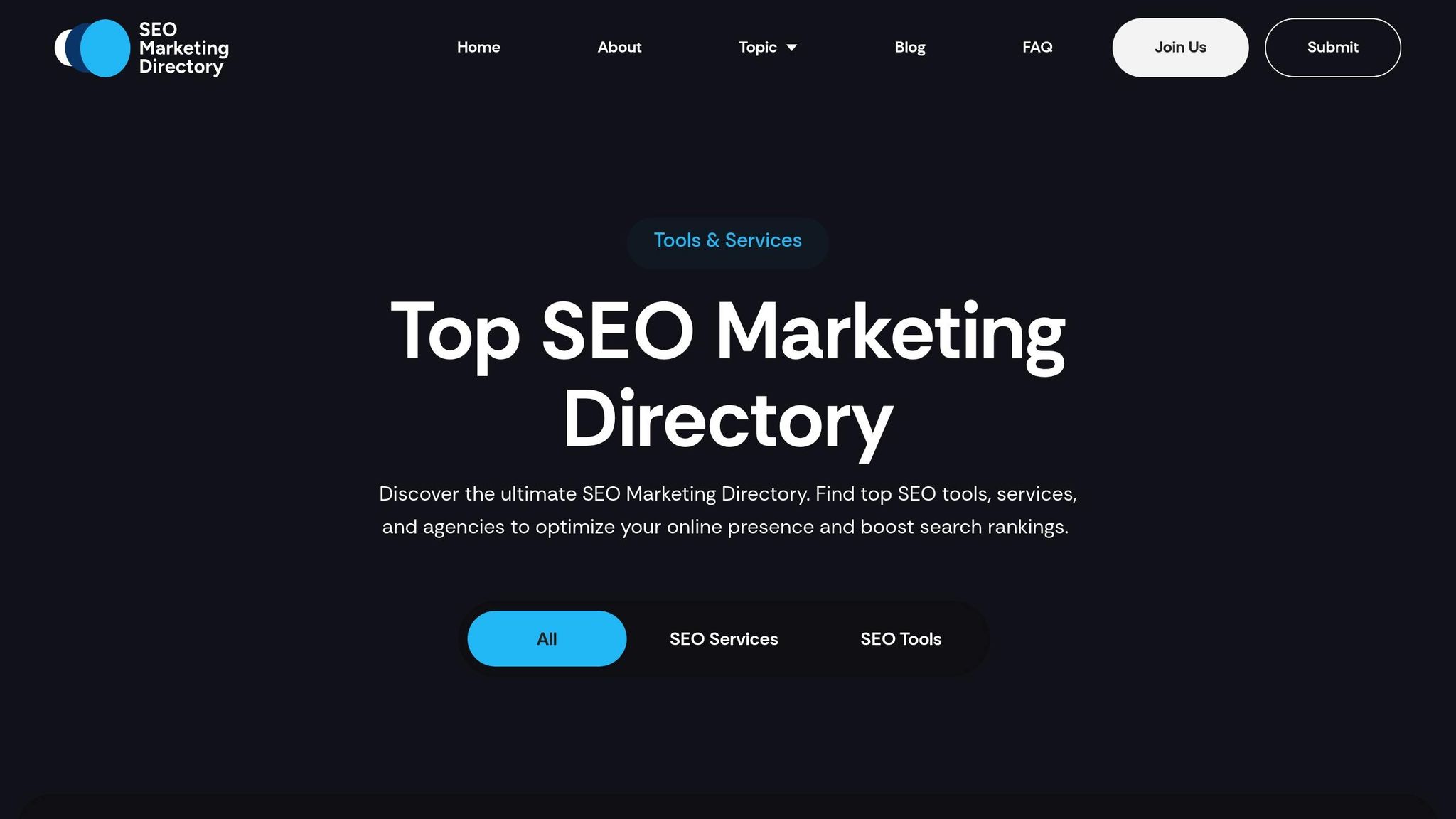Core Web Vitals are key metrics Google uses to measure website performance and user experience. They include:
- Largest Contentful Paint (LCP): Measures loading speed.
- Interaction to Next Paint (INP): Tracks responsiveness to user interactions.
- Cumulative Layout Shift (CLS): Evaluates visual stability during loading.
Improving these metrics can enhance your site's SEO and user satisfaction. Tools like Google PageSpeed Insights, Search Console, and Lighthouse help analyze and optimize these metrics. Use lab data for technical fixes and field data to understand real user experiences. Regular testing and monitoring ensure long-term performance improvements.
Key takeaway: Faster loading, better responsiveness, and stable layouts improve rankings and keep users on your site.
Core Web Vitals Assessment FAILED - Lab Data vs Field Data
Core Web Vitals Testing Tools Overview
Testing your Core Web Vitals is essential for understanding how your website performs and uncovering areas for improvement. Various tools are available, each offering unique ways to measure website performance, from controlled simulations to real-world user data. Choosing the right tool can mean the difference between surface-level observations and actionable insights that drive meaningful changes. Let’s explore the most popular tools and understand how they can help you achieve your goals.
Popular Core Web Vitals Testing Tools
Google PageSpeed Insights is one of the go-to tools for testing Core Web Vitals. It combines lab data from Lighthouse with real-world metrics from the Chrome User Experience Report (CrUX). By scoring your site on a scale of 0-100 and offering tailored recommendations, this tool not only helps diagnose performance issues but also pinpoints areas critical for improving SEO.
Google Search Console provides a dedicated Core Web Vitals report, offering insights into how your pages perform on both desktop and mobile devices. It uses real-world data that Google factors into its rankings, categorizing URLs as "Good", "Needs Improvement", or "Poor" based on the 75th percentile of user experiences over the last 28 days. This makes it invaluable for businesses looking to align their performance with Google's ranking criteria.
Chrome User Experience Report (CrUX) delivers raw field data collected from real users browsing with Chrome. While interpreting this data requires a bit of technical expertise, it offers a direct look at how actual users experience your site, making it an excellent resource for understanding performance under real-world conditions.
Lighthouse, Google's open-source auditing tool, runs directly within Chrome DevTools. It focuses on lab data, offering a controlled testing environment that eliminates variables like network speed or device performance. This makes it especially useful for identifying and addressing technical issues.
WebPageTest stands out for its advanced capabilities, allowing you to simulate different connection speeds, devices, and even geographic locations. For businesses in the U.S., this tool can test performance from multiple cities, helping you understand regional variations in user experience.
Lab Data vs. Field Data: Understanding the Difference
Knowing the difference between lab data and field data is key to making sense of Core Web Vitals results. Lab data is gathered in controlled environments where factors like device performance, network conditions, and browser settings are consistent. Tools like Lighthouse use lab data to simulate standardized conditions, making it easier to identify technical issues.
On the other hand, field data reflects real user experiences. It captures the full range of devices, connection speeds, and user behaviors that affect your site's performance. For example, the Chrome User Experience Report aggregates this data from millions of Chrome users worldwide, offering a comprehensive view of how your site performs in real-world conditions.
While lab data can pinpoint technical problems in a predictable setting, it doesn’t always account for the challenges faced by users with older devices or slower internet connections. Conversely, field data provides a realistic performance snapshot but can make diagnosing issues more complex. For instance, a site with excellent lab scores might still perform poorly in the field if most visitors use outdated smartphones or have limited bandwidth.
The best approach is to combine both types of data. Use lab data to identify and resolve technical issues, then rely on field data to ensure those fixes translate into better performance for real users. Together, these insights can directly improve your site's SEO and user experience.
Tool Comparison for US-Based Businesses
| Tool | Data Type | Best For | Key Advantage | Limitations |
|---|---|---|---|---|
| Google PageSpeed Insights | Lab + Field | General optimization | Combines lab and field data with actionable tips | Limited ability to track historical data |
| Google Search Console | Field | SEO-focused monitoring | Aligns with Google's ranking metrics | 28-day delay in reporting |
| Lighthouse | Lab | Technical debugging | Provides consistent, controlled testing conditions | Doesn’t reflect real-world performance |
| Chrome User Experience Report | Field | Real user insights | Offers comprehensive real-world data | Requires technical skills to analyze |
| WebPageTest | Lab | Custom testing and geographic insights | Simulates performance from different U.S. locations | Steep learning curve for beginners |
For most U.S. businesses, Google PageSpeed Insights offers the right balance of ease of use and detailed insights. E-commerce companies often benefit from Google Search Console, as it provides SEO-focused data directly tied to rankings. Technical teams might prefer Lighthouse for its in-depth debugging capabilities, while businesses targeting diverse regions should explore WebPageTest to ensure consistent performance across the country.
Your choice of tool depends on your business size, technical expertise, and specific needs. Smaller businesses may find PageSpeed Insights sufficient for basic improvements, while larger enterprises often rely on multiple tools for a more comprehensive view. Next, we’ll walk through how to run these tests and optimize your site for better performance.
How to Test Core Web Vitals Step-by-Step
Testing your Core Web Vitals doesn't have to be overwhelming. With the right tools and a clear process, you can quickly spot performance issues and take steps to improve your SEO rankings. The goal is to gather accurate data that helps you make meaningful changes.
Choosing the Right Testing Tool
The size and complexity of your website will influence which tools you should use. For smaller sites, Google PageSpeed Insights is a great starting point. It's free, easy to use, and provides both lab and field data for individual pages. If you want a broader view of your site's performance, combine PageSpeed Insights with Google Search Console for site-wide monitoring.
For larger or more complex websites, using multiple tools can give you a deeper understanding. For example:
- Google Search Console for overall performance trends.
- Lighthouse for technical debugging.
- WebPageTest for advanced, detailed testing.
How often you test matters too. If you're actively making changes to your site, you might run daily tests using Lighthouse through Chrome DevTools. For ongoing monitoring, rely on periodic updates from Search Console. Always test before and after major updates to measure the impact of your changes.
Both lab and field data offer valuable insights. Once you've chosen your tools, configure their settings to gather the data you need.
Running a Test and Configuring Settings
Getting started with Google PageSpeed Insights is simple. Head over to pagespeed.web.dev, enter your URL, and run the test. The tool will automatically evaluate both mobile and desktop performance. Focus on mobile results first, as they often reflect the experience of most U.S. users.
When setting up your tests, consider your audience's behavior:
- If most of your users are on mobile devices, prioritize mobile tests since slower network speeds and processing power can affect performance.
- If your analytics show heavy desktop usage, ensure desktop performance isn't neglected.
For U.S.-based businesses, testing location settings can be crucial. Tools like WebPageTest let you choose specific locations, such as New York, Los Angeles, or Chicago, to identify potential regional performance differences. If your audience is spread across the country, testing from multiple locations ensures your site works well everywhere.
Simulate different network conditions (like slower 3G speeds) and run multiple tests to ensure consistency. PageSpeed Insights automatically runs several tests and reports the median result, but with other tools, running at least three tests can help you identify consistent patterns and filter out anomalies caused by temporary network or server issues.
Reading and Understanding Test Results
Once you've run your tests, it's time to interpret the results. Here's how Core Web Vitals are measured:
- Largest Contentful Paint (LCP): This measures loading performance. An LCP of 2.5 seconds or less is considered "Good", while 2.5–4.0 seconds indicates room for improvement. Anything over 4.0 seconds is poor.
- Interaction to Next Paint (INP): This metric, which replaced First Input Delay in 2024, tracks how quickly your site responds to user interactions. A score of 200 milliseconds or less is ideal. Scores between 200–500 milliseconds suggest improvements are needed, while anything above 500 milliseconds can frustrate users and hurt SEO.
- Cumulative Layout Shift (CLS): This measures visual stability. A CLS score of 0.1 or less is "Good", while scores between 0.1 and 0.25 indicate minor layout issues. Anything above 0.25 signals significant problems.
Google's 75th percentile rule is important here: at least 75% of your page loads must meet the "Good" thresholds for all three metrics. This ensures your site performs well for most users, including those on slower devices or connections.
Keep in mind that tools like Google Search Console show performance data from the past 28 days. If you've recently implemented changes, it may take time for those optimizations to show up in the reports. The Chrome User Experience Report provides a broader view by aggregating data from millions of Chrome users.
Lab data can help you identify specific technical issues. For instance, if Lighthouse reports a poor LCP score, check its recommendations - they might point to large images, render-blocking resources, or slow server responses. Testing fixes in a controlled environment ensures your changes work before affecting real users.
Most tools use color-coded results to make interpretation easier:
- Green means good performance.
- Orange signals areas that need improvement.
- Red highlights critical issues.
Start by addressing the red metrics first. These are the areas where improvements will have the most noticeable impact on both user experience and SEO.
sbb-itb-5be333f
How to Interpret Results and Improve Core Web Vitals for SEO
Once you've got your test results, the next step is where the real progress happens. Core Web Vitals scores are a reflection of user experience and have a direct impact on your SEO performance. Understanding and prioritizing these scores will help you make the right changes to improve both user experience and search rankings.
Understanding Core Web Vitals Scores
Start by reviewing your LCP (Largest Contentful Paint), INP (Interaction to Next Paint), and CLS (Cumulative Layout Shift) scores against Google's thresholds. Here's the catch: Google uses the 75th percentile rule to evaluate performance. For example, even if 80% of your page loads meet the "Good" LCP score but only 70% hit the INP threshold, your page fails Google's Core Web Vitals assessment. To pass, at least 75% of real user experiences must meet the "Good" threshold for all three metrics at the same time.
Once you understand where your scores stand, the next step is to identify the specific issues dragging each metric down.
Finding Problem Areas
Pinpointing the root causes of poor Core Web Vitals scores involves digging into the diagnostic data provided by your testing tools. The goal is to match specific technical issues to the metrics they're impacting.
- Low LCP scores often result from large, unoptimized images or slow-loading scripts.
- High INP scores usually indicate JavaScript problems, like heavy scripts that delay user interactions.
- Poor CLS scores are often caused by images without defined dimensions, ads loading late, or fonts that cause layout shifts when they render.
To focus your efforts, use field data from tools like Google Search Console's Core Web Vitals report. This will highlight URLs with the most significant problems. Prioritize fixing high-traffic pages with poor scores - improving these pages will have a bigger impact on your SEO than optimizing low-traffic pages with similar issues.
Pay attention to geographic differences in performance. For instance, if your site performs well on the West Coast but struggles in the Southeast, it could signal issues with your content delivery network or server locations.
Tracking Improvements Over Time
Once you've addressed the problem areas, it's crucial to monitor your Core Web Vitals regularly to measure the impact of your changes. Start by setting baseline metrics and track progress with weekly tests. Document every change you make along with the corresponding score improvements.
| Metric | Baseline (Jan 1) | After Image Optimization (Jan 15) | After Lazy Loading (Feb 3) | Current (Feb 28) |
|---|---|---|---|---|
| LCP | 4.2 seconds | 3.1 seconds | 2.4 seconds | 2.3 seconds |
| INP | 380ms | 375ms | 320ms | 295ms |
| CLS | 0.18 | 0.16 | 0.12 | 0.09 |
Keep in mind that field data improvements in Google Search Console can take 2-4 weeks to show up. That's because Google needs to gather enough real user data before updating its reports. If you're eager to see immediate results, use lab data from tools like Lighthouse, which will confirm whether your optimizations are effective.
Track your SEO performance metrics alongside Core Web Vitals improvements. Look for changes in search rankings, organic traffic, and user engagement metrics like bounce rate and time on page. Many websites notice gradual improvements in search visibility about 4-6 weeks after consistently hitting "Good" thresholds for Core Web Vitals.
Finally, consider seasonal patterns and traffic spikes when evaluating your scores. For example, e-commerce sites often experience worse Core Web Vitals during busy periods like Black Friday, when servers are under heavy load. Plan your optimizations accordingly and test your site's performance under realistic traffic conditions.
Set up automated monitoring to catch any regressions early. Updates to plugins, new content, or server changes can sometimes negatively impact your scores. Weekly automated tests can help you spot issues before they start affecting your SEO performance.
Using the Top SEO Marketing Directory for Core Web Vitals Optimization

Once you've analyzed your site's performance using testing tools, the next logical step is to implement effective solutions. While basic tests can identify problems, improving server response times, optimizing JavaScript, and refining caching strategies often requires expert knowledge.
How the Top SEO Marketing Directory Supports Businesses
The Top SEO Marketing Directory makes it easier to find trusted tools and services to improve your site's Core Web Vitals. Instead of spending hours researching technical SEO solutions, you can turn to the directory's well-organized listings. Categories like technical SEO, SEO optimization, and mobile SEO help you quickly identify the right resources - whether you need a full technical audit, page speed optimization tools, or ongoing performance monitoring. Each listing is carefully reviewed, ensuring you’re accessing reliable and effective options.
Accessing Expert SEO Solutions Through the Directory
For businesses in the U.S., the directory connects you with agencies familiar with local SEO challenges, making it simpler to compare providers and choose the best fit. Many of the listed services focus on long-term monitoring and maintenance, ensuring your site's performance remains consistently strong. These experts also help you stay ahead of the curve as SEO trends and requirements change.
Keeping Up with Technical SEO Best Practices
As search engine algorithms evolve, so do the standards for Core Web Vitals and technical SEO. The directory caters to a range of needs, offering tailored solutions for both startups and large enterprises. By keeping tabs on emerging trends and performance benchmarks, the directory ensures its services remain relevant and aligned with current SEO demands.
Conclusion
Focusing on Core Web Vitals is a must for staying competitive in SEO. As Google continues to emphasize user experience in its ranking algorithms, neglecting metrics like Largest Contentful Paint (LCP), Interaction to Next Paint (INP), and Cumulative Layout Shift (CLS) can leave businesses struggling to keep up in search results.
But testing alone isn’t enough - real optimization requires expert solutions and ongoing monitoring. Common hurdles like server performance, JavaScript execution, and caching often call for specialized knowledge to address effectively.
That’s where resources like the Top SEO Marketing Directory come in. This directory connects businesses with specialists who excel in technical SEO, optimization strategies, and performance tracking. By aligning expert services with your testing data, you can tackle complex challenges and see measurable improvements. In fact, data shows that businesses listed in directories like this experience 2.7× more search appearances and up to 58% more visits.
Maintaining competitive Core Web Vitals scores isn’t a one-and-done task. Both your website and Google’s standards will continue to evolve, making regular monitoring and updates essential. By pairing thorough testing with expert guidance and consistent optimization, businesses can ensure their sites meet current performance benchmarks and stay ahead of the curve.
The payoff? Improved rankings, a better user experience, and higher conversions.
FAQs
What’s the best way to choose a Core Web Vitals testing tool for my website?
When choosing a Core Web Vitals testing tool, consider those that deliver real-world performance metrics, offer in-depth analysis, and provide consistent monitoring. The right tool should match your goals - whether it's assessing user experience, pinpointing loading problems, or keeping tabs on performance over time.
It's also smart to select tools that integrate seamlessly with your current setup. Features like competitor benchmarking or practical recommendations can make a big difference, helping you simplify your optimization efforts and improve your site's SEO results.
What are the most common issues that hurt Core Web Vitals scores, and how can I fix them?
Several things can drag down your Core Web Vitals scores, such as slow server response times, oversized image files, excessive JavaScript, and delays in loading key page elements. These problems can make your pages sluggish and frustrate users, leading to a less-than-ideal experience.
Here’s how you can tackle these issues:
- Upgrade your hosting or implement a Content Delivery Network (CDN) to reduce server response times.
- Optimize your images by resizing them, converting them to WebP format, and enabling lazy loading to ensure they load only when needed.
- Streamline JavaScript by cutting out unnecessary scripts and deferring non-essential resources.
Fixing these bottlenecks not only enhances your Core Web Vitals but also gives your website a performance boost, which can positively influence your SEO rankings.
How often should I check my website's Core Web Vitals to maintain strong SEO performance?
To keep your website running smoothly and in line with SEO best practices, it's smart to keep an eye on your Core Web Vitals regularly. Since these metrics are usually updated every 28 to 30 days, testing them at least once a month is a practical approach. This helps you spot performance trends, tackle any issues quickly, and maintain a seamless experience for your users.
If your site sees frequent updates or handles a lot of traffic, you might want to check even more often - weekly, for example. Regular monitoring ensures you're ahead of any changes that could affect your site's search rankings.


